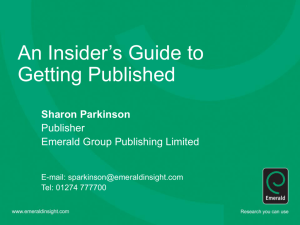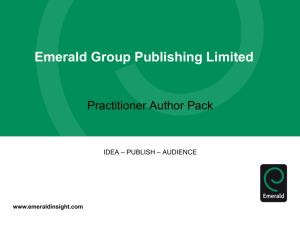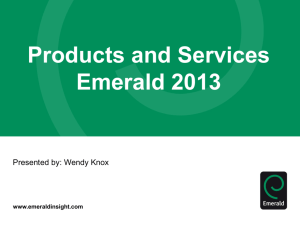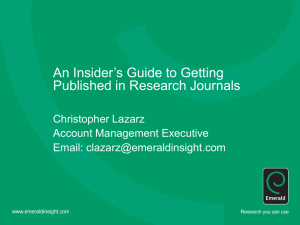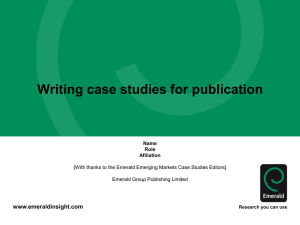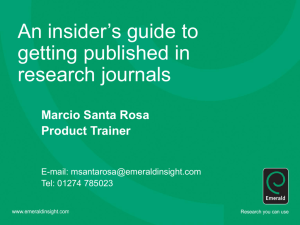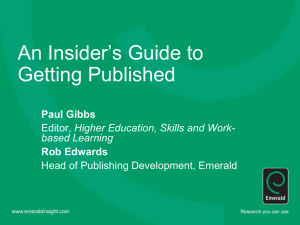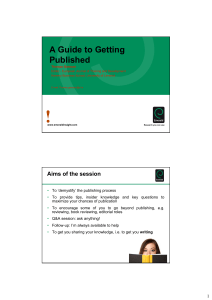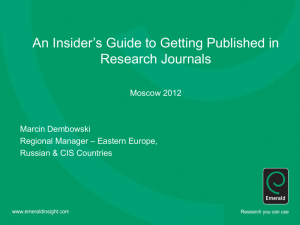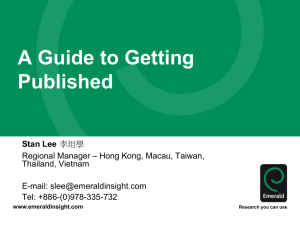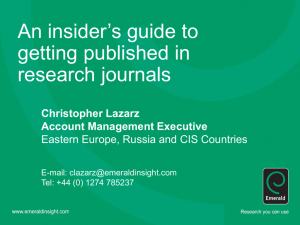Research
advertisement
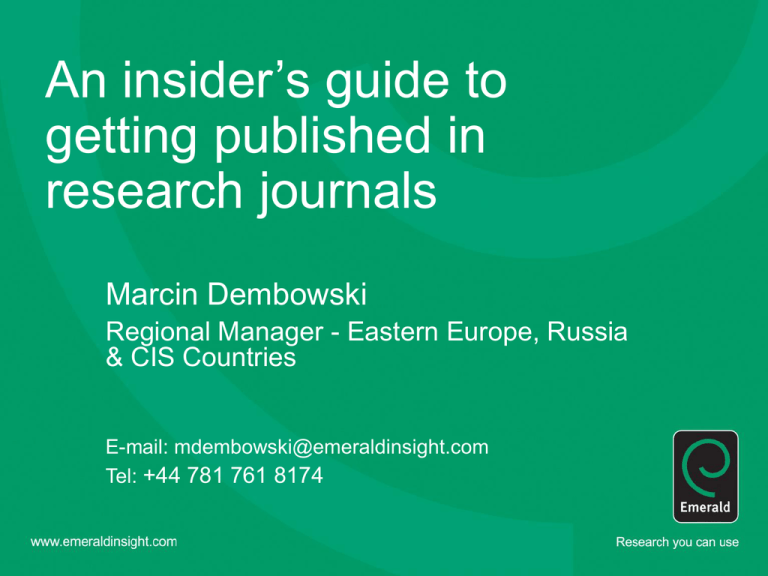
An insider’s guide to getting published in research journals Marcin Dembowski Regional Manager - Eastern Europe, Russia & CIS Countries E-mail: mdembowski@emeraldinsight.com Tel: +44 781 761 8174 Aims of the session • To ‘demystify’ the publishing process • To provide tips, insider knowledge and key questions to maximize your chances of publication • To encourage some of you to go beyond publishing, e.g. reviewing, book reviewing, editorial roles • Q&A session: ask anything! • Follow-up: I’m always available to help • To get you sharing your knowledge, i.e. to get you writing Emerald Group Publishing – company background • Emerald Group Publishing Limited (formerly MCB University Press) • Founded in 1967 in Bradford, West Yorkshire • Over 250 employees. Offices in China, India, Malaysia, Australia, Japan, Brazil, Dubai, USA • 200+ journals, 241 book series and 300 standalone texts • Electronic databases: Emerald Management eJournals and Emerald Management First • Over 1,600 university library subscribers, including 98 of the FT top 100 business schools • Potential readership of 15 million Emerald’s publishing philosophy • We believe that good management can – must – make a better world • We believe in inclusivity, internationality, innovation and independence • A better-managed world means better government, better business, more equality, meritocracy of race, age and gender, more employment, more wealth • Supportive of scholarly research • Committed to improving author, reader and customer experience • ‘Research you can use’ What do we mean by research you can use? Research that has an impact Ideas: where to start • As well as ‘traditional’ research… • Are you working on a Doctoral or Master’s thesis? • Have you completed a project which concluded successfully? • Are you wrestling with a problem with no clear solution? • Do you have an opinion or observation on a subject? • Have you given a presentation or conference paper? • If so, you have the basis for a publishable paper Co-authorship as a possibility • With supervisor, across departments, someone from a different institution • Demonstrates the authority and rigour of the research • Especially useful for cross-disciplinary research • Ensure paper is checked and edited so that it reads as one voice • Exploit your individual strengths • Agree and clarify order of appearance of authors and the person taking on the role of corresponding author What makes a good paper? HINT: Editors and reviewers look for … • Originality – what’s new about subject, treatment or results? • Relevance to and extension of existing knowledge • Research methodology – are conclusions valid and objective? • Clarity, structure and quality of writing – does it communicate well? • Sound, logical progression of argument • Theoretical and practical implications (the ‘so what?’ factors!) • Recency and relevance of references • Internationality/Global focus • Adherence to the editorial scope and objectives of the journal • A good title, keywords and a well written abstract What should YOU be looking for ISI is the most well known ranking, but others exist e.g. • Citations are a good, but not complete, guide to quality (e.g. AACSB’s 2008 ‘Impact of Research’ paper) • Usage is a better measure of utility • Other factors to consider are recent articles, most communicative, societies and internationality • Be political (e.g. national vs international) and strategic (e.g. five articles in ‘low ranked’ journals vs one in ‘top ranked’ journal) What rankings are used here? Target! “Many papers are rejected simply because they don’t fulfil journal requirements. They don’t even go into the review process.” • Identify a few possible target journals/series but be realistic • Follow the Author Guidelines – scope, type of paper, word length, references style, etc • Find where to send your paper (editor, regional editor, subject area editor). Check a copy of the journal/series or the publisher’s web site • Send an outline or abstract and ask if this looks suitable and interesting (or how it could be made so) • Confirm how an editor would like a submission, e.g. e-mail; hard copy or online submission system • Read at least one issue of the publication – visit your library for access Example of author guidelines Every journal published will have detailed notes and guidelines How to sell your paper • Use a short descriptive title containing main keyword – don’t mislead • Write a clear and descriptive abstract containing the main keywords and following any instructions as to content and length • Provide relevant and known keywords – not obscure new jargon • Make your references complete and correct – vital for reference linking and citation indices • All of this will make your paper more discoverable which means more dissemination and possibly more citation Emerald has introduced structured abstracts • A structured abstract – in 250 words or less (no more than 100 in any one section) • Purpose – Reasons/aims of paper • Design – Methodology/’how it was done’/scope of study • Findings – Discussion/results • Research limitations/Implications (if applicable) – Exclusions/next steps • Practical implications (if applicable) – Applications to practice/’So what?’ • [NEW] Social implications (if applicable) – Impact on society/policy • Originality/value – Who would benefit from this and what is new about it? www.emeraldinsight.com/structuredabstracts Before you submit your article: your own peer review • Let someone else see it – show a draft to one or more friends or colleagues and ask for their comments, advice and honest criticism • We are always too close to our own work to see its failings • Always proof-check thoroughly – no incorrect spellings, no incomplete references. Spell checkers are not fool-proof Spot the error: Leads Metropolitan University Editorial supply chain and journal management structure: journals Author Quality research papers Editor EAB and reviewers Solicits new papers Research Handles review process Promotes journal to peers Publisher/ Managing Editor The link between the publishing company and editor Production QA – sub-editing and proof reading Access via library Convert to SGML for online databases Hard copy Helps editors succeed in their role and build a first class journal Print production Overall responsibility Despatch for journal Attends conferences Promotion and marketing Develops new areas of coverage Attends conferences Handles production issues Users Added value from publisher Database Third party Once you have submitted your article A request for revision is good news! It really is • You are now in the publishing cycle. Nearly every published paper is revised at least once • Don’t panic! • Even if the comments are sharp or discouraging, they aren’t personal Process of acceptance for a journal – just one example How to revise your paper • Acknowledge the editor and set a revision deadline • Clarify understanding if in doubt – ‘This is what I understand the comments to mean…’ • Consult with colleagues or co-authors and tend to the points as requested • Meet the revision deadline • Attach a covering letter which identifies, point by point, how revision requests have been met (or if not, why not) If your paper is rejected … • Ask why, and listen carefully! Most editors will give detailed comments about a rejected paper. Take a deep breath, and listen to what is being said • Try again! Try to improve the paper, and re-submit elsewhere. Do your homework and target your paper as closely as possible • Don’t give up! At least 50% of papers in business and management don’t get published. Everybody has been rejected at least once • Keep trying! How to promote your work • Why? Influence policy = credibility; Raise profile of institution and discipline area; Attract collaborators and funding; New areas and opportunities for you (consulting, media) • How? Use your network, press releases, associations/societies, engage, hone your media skills, ‘brand image’ • See Support and services for authors and Editors on the USB stick for more info Emerald: Supporting Research Emerald world wide representation author distribution and Emerald’s product range: supporting international scholarly research Emerald: Supporting Research • Supporting authors and researchers • Services for authors and researchers • Author workshops Emerald supporting authors • More than 80,000 authors worldwide are members of the Emerald Literati Network– a huge ‘expert network’ • Complimentary journal issue and five reprints upon publication • For Researchers www.emeraldinsight.com/research – Outstanding Doctoral Research Awards – Research Fund Awards – How to… guides – Emerald Research Connections • For Authors www.emeraldinsight.com/authors – How to… guides – Meet the Editor interviews and Editor news – Editing service – Annual Awards for Excellence – Calls for Papers and news of publishing opportunities Other useful resources • www.isiwebofknowledge.com (ISI ranking lists and impact factors) • www.harzing.com (Anne-Wil Harzing's site about academic publishing and the assessment of research and journal quality, as well as software to conduct citation analysis) • www.scopus.com (abstract and citation database of research literature and quality web sources) • www.cabells.com (addresses, phone, e-mail and websites for a large number of journals as well as information on publication guidelines and review information) • www.phrasebank.manchester.ac.uk (a general resource for academic writers, designed primarily with international students whose first language is not English in mind) What do you use? Beyond authorship Other important journal publishing work that you might wish to get involved in includes: • Book reviewing • Refereeing/peer review • Editorial advisory board membership • Contributing editorship • Regional editorship • Editorship For details of opportunities in this area please do get in touch with us! Talk to us, use us! • Tell us how we can help you • Give us feedback online • Use Emerald Management eJournals For any answers you didn’t get today (or were too shy to ask) … Marcin Dembowski at: mdembowski@emeraldinsight.com Tel: +44 (0)1274 785136 Write for us!
